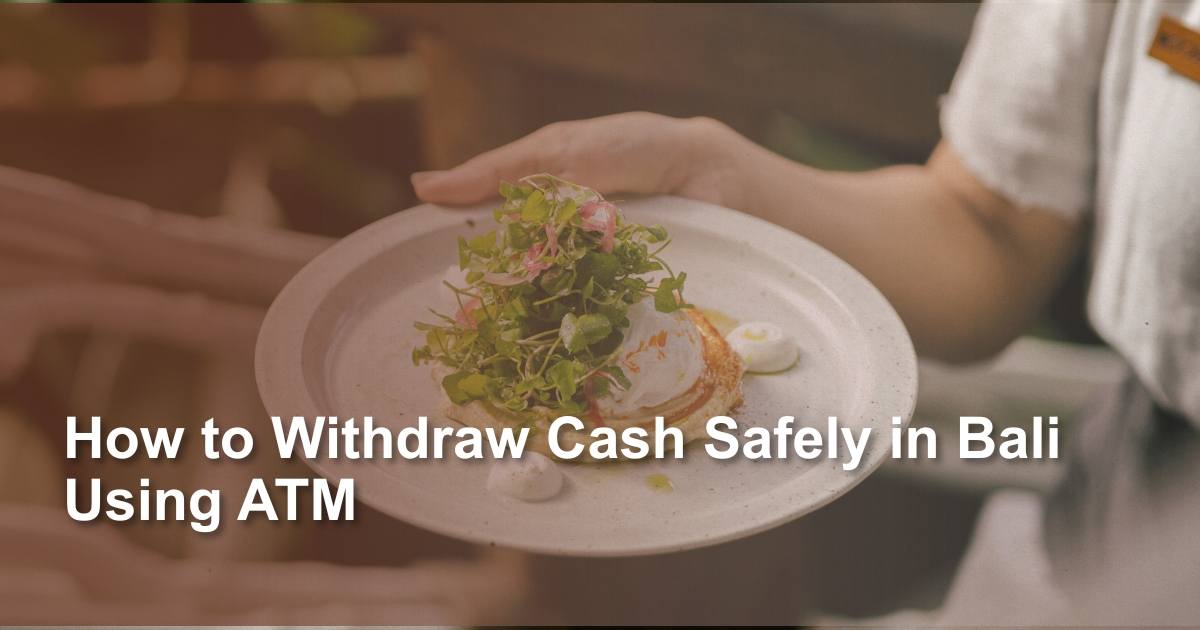I quickly learned that cash is king in Bali. From paying for a motorbike taxi to grabbing a plate of nasi goreng at a local warung, many places simply don’t accept cards. On my first day, I found myself searching for an ATM, a little nervous about which ones were safe and how much I could actually withdraw. After a while, I figured out the best ways to take out money without stress, and I want to share those tips with you here.
Do You Really Need Cash in Bali?
Yes, you do. While larger hotels, beach clubs, and some restaurants accept cards, everyday life in Bali still runs on cash. Street food stalls, market vendors, small shops, and even some local transport options expect rupiah. I’ve often found myself pulling out bills for things like temple entrance fees, bottled water, or a ride on the back of a scooter. Having cash on hand saves you time and hassle.
Choosing the Right ATM in Bali
Not all ATMs in Bali are reliable. The safest options are those connected to major Indonesian banks such as:
- BCA (Bank Central Asia) – largest ATM network, widely available across the island.
- BNI (Bank Negara Indonesia) – common in tourist areas, airports, and shopping centers.
- Mandiri – often allows slightly higher withdrawal limits.
- BRI (Bank Rakyat Indonesia) – useful if traveling outside main tourist hubs.
ATMs located inside or directly beside a bank branch are considered the safest. They are usually monitored by security and cameras. Machines in shopping malls, supermarkets, and larger convenience stores such as Circle K, Indomaret, or Pepito Market are also generally safe and convenient. It’s best to avoid standalone ATMs on quiet streets, especially in tourist areas like Kuta or Seminyak, as these are more vulnerable to tampering.
Withdrawal Limits in Bali
Most ATMs in Bali have withdrawal limits. Many machines only allow up to 2,000,000 to 3,000,000 IDR per transaction (about 130–200 USD), depending on the bank. Some larger ATMs let you take out more, but it often means making several transactions if you need a bigger amount. I usually plan ahead and withdraw enough for a few days at a time rather than relying on daily trips to the ATM.
- BCA and BNI ATMs – usually allow withdrawals of up to 2,500,000 IDR per transaction.
- Mandiri ATMs – often allow 3,000,000 IDR or more per transaction.
- Premium ATMs (usually in airports and malls) – sometimes allow 5,000,000–6,000,000 IDR, though they are less common.
Since many machines only dispense 50,000 or 100,000 IDR notes, carrying small change can be difficult. Choosing “50,000 IDR notes” when available is more practical, as smaller shops, taxis, and food stalls may not have change for 100,000 IDR bills.
ATM Fees in Bali
Foreign cards almost always come with fees. My home bank charges an international withdrawal fee, and on top of that, the local bank in Bali adds its own small fee. It’s not unusual to pay between 30,000–75,000 IDR (around 2–5 USD) per withdrawal. To save money, try to make fewer, larger withdrawals instead of many small ones. It’s also worth checking if your bank has any partnerships with Indonesian banks, which can sometimes reduce fees.
- Local bank fee – typically 30,000–75,000 IDR (2–5 USD) per withdrawal.
- Home bank or card issuer fee – varies depending on your bank; often a flat fee or a percentage of the transaction.
- Currency conversion margin – exchange rates offered by ATMs may include additional charges.
To minimize costs:
- Withdraw larger amounts less frequently.
- Check if your bank partners with Indonesian banks to reduce fees.
- Consider travel debit cards such as Wise, Revolut, or Charles Schwab, which often offer lower fees and better exchange rates.
Safety Tips for Withdrawing Cash in Bali
This was something I learned both from local advice and personal experience: while Bali is generally safe, ATM scams and skimming do exist. Here are the rules I now follow every time I withdraw:
- Choose ATMs attached to banks or inside malls. They’re monitored and safer.
- Avoid small, standalone ATMs on empty streets. These are more vulnerable to card skimmers.
- Cover your PIN. Some ATMs may have tiny cameras installed above the keypad.
- Check the card slot. If it feels loose or unusual, don’t use it.
- Withdraw during the day. Fewer risks compared to late at night.
- Keep an eye out for “helpful strangers.” No one should be near you while you withdraw.
- Enable SMS or app notifications with your bank to track withdrawals in real time.
Carrying and Managing Cash in Bali
Once you’ve got the cash in your hand, the next question is: how do you manage it? Bali is generally safe, but try to be smart about it. Here are my tips:
- Don’t carry all your cash at once. Keep just enough for the day and leave the rest in the hotel safe or a locked bag.
- Always break down big notes at larger shops or supermarkets, so you don’t get stuck trying to pay for a 20,000 IDR meal with a 100,000 note.
- Keep smaller bills handy for things like parking fees, bottled water, or quick snacks.
Read also : Guide to Bali Currency: Tips for Using the Indonesian Rupiah
Alternatives to ATMs in Bali
ATMs are convenient, but they’re not your only option. I’ve also tried:
- Money changers – The official ones (often marked with “Authorized Money Changer”) are safe, but I avoid the tiny roadside booths with unusually high exchange rates. Those are notorious for scams.
- Cash advances on credit cards – These are possible at some bank branches, but the fees are usually higher than ATM withdrawals.
- Digital wallets – Apps like GoPay, Dana, or OVO are popular among locals. They’re linked to Indonesian bank accounts, so as a tourist I don’t use them much, but they’re worth knowing about if you stay long-term.
FAQ About Withdrawing Money in Bali
Can I use foreign cards at Bali ATMs?
Yes. Visa and MasterCard are widely accepted. Some machines also accept Cirrus, Maestro, and Plus network cards.
Are ATMs in Bali reliable?
Most bank-affiliated ones are fine. The only issue is withdrawal limits and occasional outages in rural areas.
Is it better to bring cash or just use ATMs?
I recommend bringing a mix: some foreign cash (USD, EUR, AUD) to exchange and a debit/credit card for ATM withdrawals.
Do shops in Bali accept USD?
Not really. The official currency is Indonesian Rupiah (IDR), and most businesses expect payment in IDR.
Read also : Living in Bali in 2025: What’s It Gonna Cost You?
Final Thoughts
With a little planning, withdrawing cash in Bali becomes second nature. Choose ATMs from well-known banks, keep an eye on withdrawal fees, and take a few simple safety steps. Having rupiah in your pocket makes life on the island so much smoother, whether it’s tipping a driver, paying for temple entry, or buying fresh fruit at a roadside stand.
Bali has its challenges when it comes to money, but once you know how the system works, it’s nothing to stress about. In fact, figuring it out is part of the travel experience, one that will make you feel more confident and independent as you explore the island.










